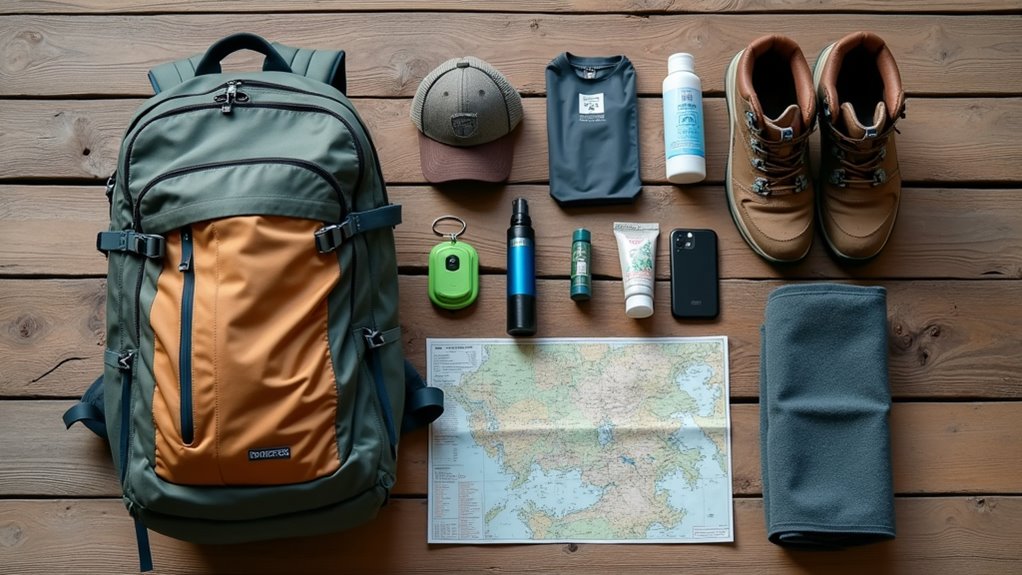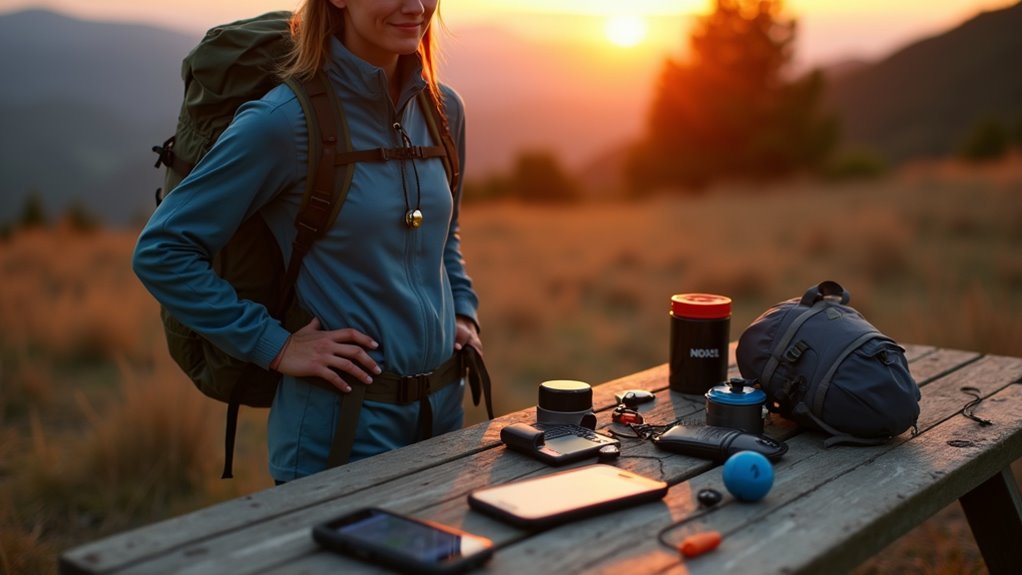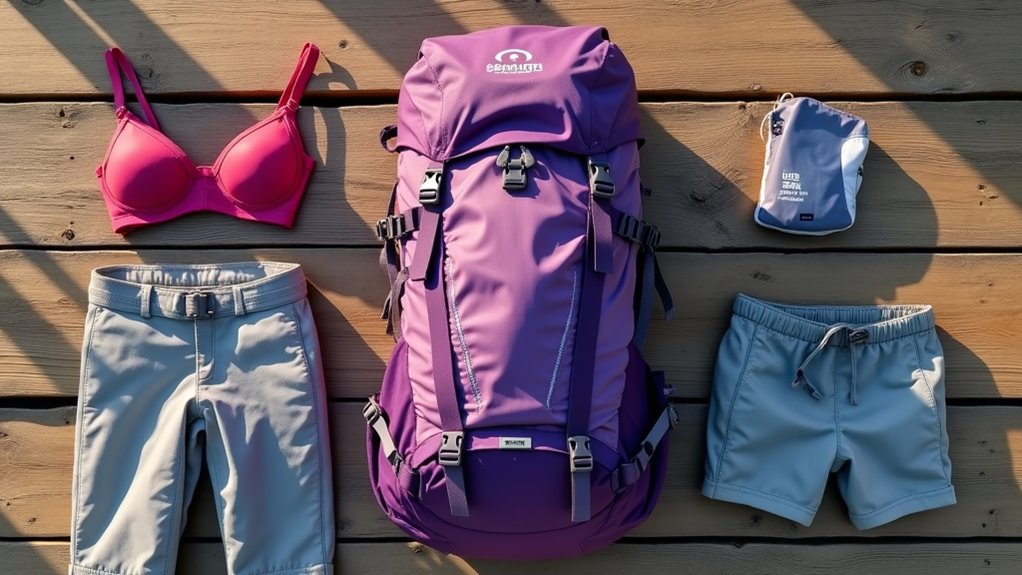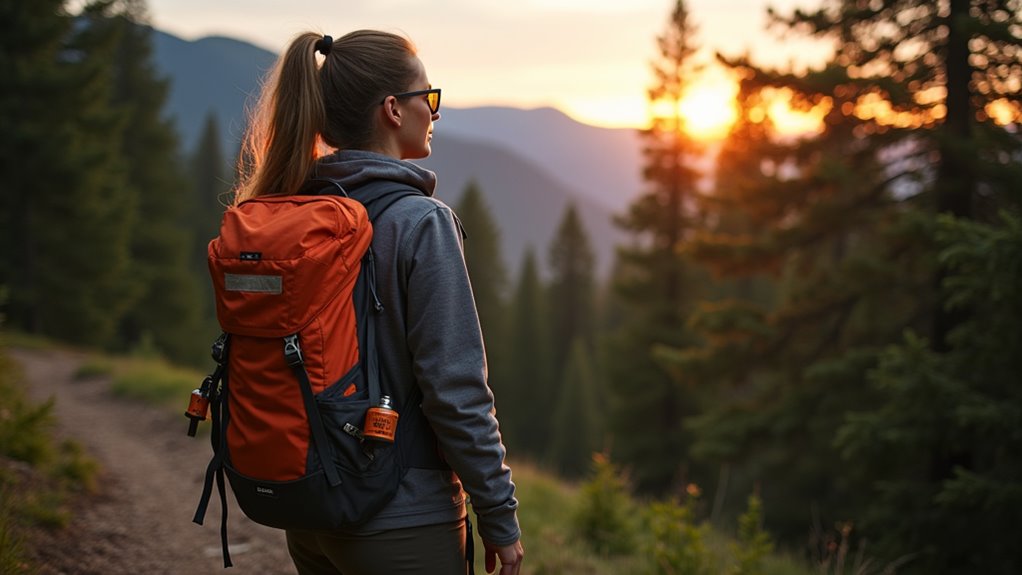Physical Address
304 North Cardinal St.
Dorchester Center, MA 02124
Physical Address
304 North Cardinal St.
Dorchester Center, MA 02124

Kickstart your solo wilderness journey with female-focused backpacking essentials that transform anxiety into empowering trail confidence.
You’ll find that 68% of female backpackers report feeling more confident after their first solo trip, despite initial safety concerns. When you’re planning your wilderness adventure, you’ll need more than just the standard hiking advice that’s typically geared toward men. From selecting female-specific gear to mastering trail safety protocols that address unique challenges, your backpacking success depends on having the right knowledge and strategies. Let’s explore the essential tips that’ll transform you from a hesitant hiker into a confident backcountry explorer.

While solo backpacking offers incredible freedom and personal growth opportunities, your safety should always be the top priority. Start by equipping yourself with essential safety tools like pepper spray and a personal alarm. Trust your instincts when meeting strangers, and maintain firm boundaries while staying polite.
Keep your valuables concealed and carry minimal cash to avoid attracting unwanted attention. It’s advisable to build confidence through proper preparation – learn basic self-defense moves and familiarize yourself with local customs before departure. With 88% of women reporting safety threats during solo travel, thorough research of your destination is crucial.
Different ways to keep yourself safe in outdoor camping can also help ensure your well-being during solo adventures. Share your itinerary with trusted contacts and keep emergency numbers readily accessible. When exploring remote areas, stick to well-trafficked trails and consider joining other travelers. Use GPS tracking apps to stay oriented, and always keep your phone charged.
Remember to promptly report any incidents to local authorities while maintaining your composure.
Three key elements form the foundation of a successful backpacking journey: thorough planning, smart route selection, and proper preparation.
Start by choosing well-marked trails within 5 miles of the trailhead for your first adventures. You should select routes that offer cell service coverage and reliable water sources. Use platforms like AllTrails and onX Backcountry to research trail conditions and potential hazards before setting out.
Consider camping in areas with moderate foot traffic, especially if you’re traveling solo. Using Facebook hiking groups can help you find companions for added safety. You’ll need to check weather forecasts regularly and familiarize yourself with seasonal changes. Knowing the 5 W’s (who, what, when, where, why) is essential for a successful beginner camping trip.
Don’t forget to share your detailed itinerary with a trusted contact and leave a copy in your vehicle. When possible, connect with local hiking communities through organizations like the Washington Trails Association for current trail insights and safety updates.

Start with proper footwear: invest in waterproof hiking boots and pack several pairs of wool or synthetic socks to prevent blisters. Experts recommend bringing 30-50 liter backpacks for overnight wilderness trips. Essential camping gear is crucial for any outdoor adventure.
You’ll need strategic clothing layers, including moisture-wicking base layers and a reliable rain jacket for unexpected weather.
Don’t skimp on hydration gear – carry a water bottle or bladder plus a lightweight filter system like the Sawyer Mini.
Your shelter system should include a weather-appropriate tent, sleeping bag, and insulating pad.
For hygiene, pack a menstrual cup or tampons, biodegradable soap, and a quick-dry towel.
A compact first aid kit and trowel round out your essential gear list.
Choose lightweight, durable items that serve multiple purposes to maximize pack space and minimize weight.
Having the right gear sets the foundation, but physical readiness makes or breaks your backpacking experience. Start building endurance through regular training before hitting the trails, focusing on both cardio and strength exercises that target hiking-specific muscles.
Don’t let physical differences discourage you – women often have a natural metabolic advantage in endurance activities. Finding inspiration from fellow female hikers can boost your confidence and motivation for tackling physical challenges. Use trekking poles to reduce strain on your joints and maintain a steady pace that works for your body type.
Essential camping tips can help ensure a successful first-time adventure. Listen to your body’s signals and take breaks when needed, staying properly hydrated and fueled throughout your hike.
Build mental toughness alongside physical strength by setting realistic goals and celebrating small victories. Connect with other female hikers for support and shared experiences, and always prioritize safety by mastering basic navigation and first-aid skills.

Maintaining proper hygiene while backpacking presents unique challenges for female hikers, but smart preparation and the right tools make wilderness cleanliness manageable.
Pack essential items like a Kula Cloth or pee funnel for comfortable urination management, and opt for menstrual cups over disposable products to reduce waste.
You’ll need biodegradable soap, quick-drying towels, and hand sanitizer for daily cleanliness. Always dig proper catholes and pack out all hygiene-related waste in sealed Ziploc bags. Proper food storage and handling are essential for avoiding foodborne illnesses while camping.
Choose moisture-wicking underwear and wash it regularly to prevent discomfort and potential infections. Consider using barrier creams to prevent chafing during long hikes.
Stay hydrated and maintain good hand hygiene, especially before meals and after bathroom use.
Remember to use biodegradable products whenever possible and follow local regulations for waste disposal to minimize your environmental impact while keeping yourself healthy on the trail.
Safe backpacking extends beyond personal care to mastering reliable navigation skills.
You’ll need both digital and paper maps, a reliable compass, and a GPS device like Gaia GPS. Don’t rely solely on your phone – battery life isn’t guaranteed in the wilderness. Expert navigators understand that continuous practice builds proficiency and confidence in the backcountry.
Learn to read topographic maps and understand contour lines before hitting the trail. Practice basic navigation techniques like orienting your map, using your compass, and identifying natural landmarks. These skills become essential if you’re hiking solo or leading a group.
Master topographic maps and navigation fundamentals – they’re your lifeline when exploring remote wilderness, whether solo or with others.
Always carry an emergency whistle and reliable lighting. Essential camping gear can make a significant difference in your safety and comfort.
Before each trip, study your route thoroughly and check weather conditions. If you’re new to navigation, start with well-marked trails and gradually build your skills.
Consider joining a women’s hiking group or finding a mentor to boost your confidence in off-trail navigation.

While solo backpacking can feel intimidating at first, connecting with other female hikers will dramatically boost your confidence and skills. With 75% of solo travelers being women, you’ll find an active and welcoming community ready to support your journey.
Join women-specific hiking groups on Facebook and local meetups to access instant advice, trail recommendations, and safety tips from experienced backpackers. You’ll find countless opportunities to learn through guided experiences, skill-sharing workshops, and group hikes with more seasoned adventurers. Camping with your dog can be a fun and rewarding experience, but it’s important to keep a few essential tips in mind to ensure the safety and comfort of both you and your furry companion.
Look for women-only hiking clubs in your area that offer beginner-friendly events and workshops – they’re often free or low-cost.
Connect with online communities like “Women Who Hike” to find hiking partners, get gear recommendations, and share trail reports.
Participate in guided group hikes to learn proper techniques and build confidence before tackling solo adventures.
These supportive networks will help transform your backpacking aspirations into reality while providing valuable mentorship along the way.
Beyond building a strong hiking community, mastering weather preparedness can make or break your backpacking experience.
You’ll need to invest in versatile gear that adapts to changing conditions, starting with a reliable three-season tent and emergency bivy for unexpected cold snaps. Always bring bear spray if hiking in areas known for wildlife encounters. Essential strategies for cold-weather camping survival can help you prepare for colder temperatures.
Don’t skimp on hydration – carry at least 0.5 liters per hour and map out water sources beforehand.
For sun protection, combine breathable clothing with broad-spectrum sunscreen and a wide-brimmed hat.
Layer strategically with moisture-wicking base layers and waterproof outer shells for wet conditions.
Adjust your gear based on seasons: pack lighter for summer treks and add insulation for winter adventures.
Always check weather forecasts and bring emergency signaling devices.
Your sleeping bag should be rated for the lowest expected temperature, and don’t forget extra fuel for cold-weather cooking.

Understanding wildlife behavior forms the foundation of safe backpacking, especially for solo female travelers.
You’ll need to stay alert during your hikes and make continuous noise to prevent surprising animals. Don’t store food in your tent, and always use bear-resistant containers or proper hanging techniques to secure your supplies at least 200 feet from your campsite. For additional protection, be sure to clean cookware properly after meals. Knowing bear safety is crucial when camping in bear country.
If you encounter wildlife, stay calm, stand tall, and back away slowly.
Never run, as this can trigger a chase response.
Before heading into the wilderness, establishing reliable communication plans and emergency protocols can mean the difference between a minor setback and a serious crisis.
Start by designating emergency contacts who’ll track your itinerary and expect regular check-ins. Purchase a local SIM card or eSIM for reliable data access, and consider carrying a personal locator beacon for areas without cell service. Keeping a secure digital backup of all important travel documents provides an extra layer of safety during your journey.
Reliable connectivity and trusted contacts can be your lifeline in remote areas – plan your communication strategy before departure.
Create an extensive safety kit and familiarize yourself with local emergency numbers. Download essential navigation apps and keep them updated. Essential tips for a safe and enjoyable camping adventure can help ensure your trip is both memorable and safe.
You should consider joining online backpacking communities for real-time advice and support. When traveling solo, use technology wisely – invest in a portable charger and safety apps like bSafe or Life360.
Remember to share your plans with trusted contacts, but avoid posting real-time locations on social media.
Pack purposefully, prepare proficiently, and you’ll powerfully navigate your wilderness journey. Trust your training and the tips you’ve learned to tackle the trails confidently. Don’t skimp on safety gear, but save smartly by investing in essential items first. You’re ready to roam responsibly, knowing you’ve mastered the mindset and methods for successful solo backpacking. Stay strong, stay safe, and savor your solitary adventures.